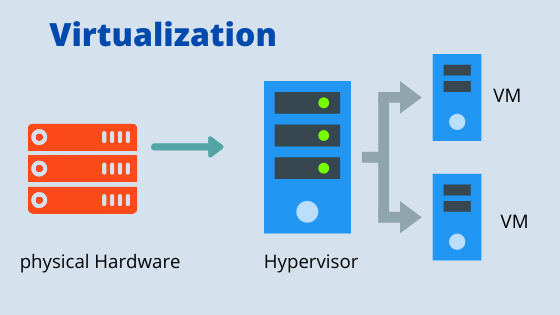Virtualization: what it is and what benefits it gives
11.12.2023
The virtualization technology has existed ever since the 1950s. Then the IBM Company wanted to enhance the computers' capacity through “time distribution”.
Nowadays, business wants to have quick access to information, manage IT infrastructure easily and flexibly, have a chance to save yet more volumes of data. And all of it is possible thanks to the virtualization alone.
Read below what this technology is, how it works and what benefits it gives.
What is virtualization?
Virtualization is a technology that enables running several operating systems on one physical server.
Imagine you have three physical servers. One hosts email, the other one — website, and the third one — corporate software. Everything seems to be logical. But at the same time, each server is approximately 30% engaged, which is just a part of its work capacity. This is how most companies used to work. With virtualization, one can, for instance, divide an email hosting server into two independent ones, and also host a website there. This way, you can enhance one server’s performance from 30% up to 60%, or even 90%. The unoccupied servers could be used for other tasks or decommissioned at all.
So, the virtualization ensures a better workload mobility, increases performance and sources availability, automates processes and reduces the price of owning IT infrastructure.
History of virtualization
The virtualization technology development springs from the 1950s. The IBM Company was using a large mainframe costing over $2M. In order for enabling more people to work with it, they came up with a time-sharing or ‘time distribution regime’. The computers were connected to the terminals (something resembling the modern screens). People were working with it as if simultaneously, but in fact the computer was solving tasks in turns, taking little time for each one. It made mainframes more accessible.
In the 1980s, virtualization technology was used to test systems or to allow multiple systems to share access to files or data without having to share a computer network.
In the mid-1990s, with the advent of virtual workstations (VWS), virtualization began to be involved in corporate computing. VWS allowed users to run custom versions of Microsoft Windows on their PCs without having to buy a new computer.
In 2006, Microsoft released its first commercially available Hyper-V product, which allowed users to run multiple instances of Windows Server simultaneously on any number of x86-based computers running Windows Server 2003 (or later) Enterprise Edition or Standard Edition. This allowed users to consolidate servers with identical hardware configurations into fewer physical servers and potentially save money by reducing maintenance costs.

Virtualization technology work principles
How the technology works
A special software is installed on one piece of hardware, a hypervisor, which allows for creating several virtual computers on one physical server. They are called virtual machines (VM for shorts). This way, there can be several virtual servers inside a physical one, each working independently of the others.
Various operating systems and apps could be installed on virtual machines, and they do not intersect in any way with the neighboring virtual machines. Thereby, a virtual machine is a logically isolated and quota-restricted volume of resources, which emulates the real server behavior, has its own operating system and set of apps.
A set of resources-sharing servers are called a cloud.
Virtualization types
Server virtualization. In this case, one physical server is divided into a few virtual ones. This allows the company to economically use technical resources and deploy IT services.
- Data virtualization. Companies collect data from different sources, in various formats and store it on different platforms: local server or data center, cloud. Virtualization creates a software layer between data and the applications that use it. Virtualization tools handle application requests for data and return the results in the appropriate format. Thus, companies use data virtualization solutions to increase the flexibility of data integration and support multi-functional information analysis.
- Storage virtualization. Since data from several network storages are combined into one main one and controlled through it, it guarantees the security of data storage. Repositories also have advanced replication and disaster recovery capabilities that make certain IT operations more flexible.
- Network virtualization. The goal of network virtualization is to break down the complexity of a network into manageable components. Network bandwidth is divided into multiple channels and then allocated to the server and devices in real time. In the telecommunications sector, it is customary to virtualize networks to reduce the number of physical components: switches, routers, servers, cables and hubs, which is crucial for building independent networks.
- Desktop virtualization. It is implemented using the infrastructure of virtual desktops (Virtual Desktop Infrastructure, VDI). You can use the solution to run different desktop operating systems on virtual machines that your teams can access remotely. This type of virtualization provides efficient and secure desktop management, saving you money on desktop hardware.
- Application virtualization. Because applications reside on a centralized server, virtualization helps users access them even if they are incompatible with their device's operating system. This way, Windows programs will be able to run in Linux OS.

66% of companies report increased agility through virtualization in 2023
Advantages of virtualization technology
Resource optimization and cost reduction
Since the company does not need to buy physical equipment, maintain it or replace it in case of failure, it can save money and spend it on the development of new projects, etc. It also makes it possible to free up the IT team for more interesting tasks aimed at business development.
Independence from hardware
The ability to deploy virtual machines on any hardware has no limitations. VMs are standardized and universal. Virtualization allows you to combine different services without having to buy servers or PCs for them. User can run virtual machines and OS simultaneously. For example, it is possible to work on one Windows computer and at the same time run Linux, but in a different window.
Fault resistance and disaster resistance
To install the required software, drivers are needed. And when something happens to the equipment on which it is placed, you need to transfer it to the similar one. And this takes time. If some force majeure happens to the VM, the hypervisor will redistribute its resources to another one, and the applications will continue to work. So the business will be able to avoid downtime.
Convenience and mobility
Virtualization provides more freedom in work. Employees will be able to connect to the necessary programs at any time, from any device and from any part of the world where there is an internet connection.
Read also what cloud computing is, which would be impossible without virtualization.





